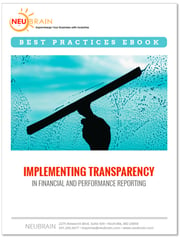Government mandates to be more transparent have gone a long way to make information more available to the public, but posting raw data on a website doesn’t automatically make it accessible or digestible. Agencies still need to present the information – often about budget and performance – in ways that make immediate sense to average citizens. Sharing formulated strategy, implementation progress and performance results help taxpayers understand how strategic goals translate into dollars, so they can see how their money makes a difference.
Citizens are not the only beneficiaries in this scenario. Transparency also forces government administrators to run operations more efficiently, and fostering citizen engagement through data sharing helps government officials better understand the priorities of individuals and communities.
Becoming more transparent doesn’t happen instantaneously. It requires planning and processes to ensure that the data to be shared is accurate and well presented. Some states and localities nationwide have embraced the transparency movement and taken advantage of new technologies that support it, while others are slower to adopt them. Let’s look at a few practices that can help government organizations release not just data, but useful information that can inform more educated decisions about budgeting and policy.
First, traditional line-item budgeting needs to give way to performance-based budgeting (PBB), which offers greater efficiency, cost savings, accountability, transparency and improved services to citizens. It provides real transparency by increasing citizens’ understanding of how agencies spend money through its philosophy of promoting resource allocation according to how effectively a program or service achieves its goals.
Next, agencies need to overcome several obstacles. They include:
- Culture – Pushback from employees is common any time process or technology change. Some workers may see sharing information as opening the organization to criticism. Agency leaders can play an important role in assuaging these concerns.
- Training – Investments in educating employees on data analytics and visualization tools that help promote transparency are critical to the cultural shift and to providing real information.
- Transparency strategy and process – Agencies need to map a strategic and ongoing approach.
- Missing tools – Enterprise resource planning and traditional financial systems don’t go far enough when it comes to transparency. Organizations need more specific and automated tools.
Agencies also need to decide what information to make transparent. Common types are budgets, key economic indicators, scorecards and open checkbooks. These datasets are just a sampling of what could be included; many more are needed to create a robust transparency program.
Even after selecting the datasets to open, government officials need to figure out exactly what data is most relevant and the best ways to present it. For example, both summary and detail data should be included to add context and avoid overwhelming users. Additionally, data should be up-to-date, easy to find and extract, and auditable.
The key that brings all these components of transparency together is visualization, often in the form of a dashboard. Dashboards should fit on a single computer screen and provide all of the most important information at a glance. This means avoiding clutter, using the right graphs to illustrate the data and designing so that the eye is drawn to the most important information first.
The next generation of outcomes-focused business analytics technology is specifically designed to produce needed data and reports efficiently and sustainably, helping government agencies institutionalize their commitment to transparency and accountability. This technology has the potential to revolutionize the way in which government operations are budgeted and valued.

LEARN HOW TO IMPLEMENT
TRANSPARENCY
IN FINANCIAL AND PERFORMANCE REPORTING


